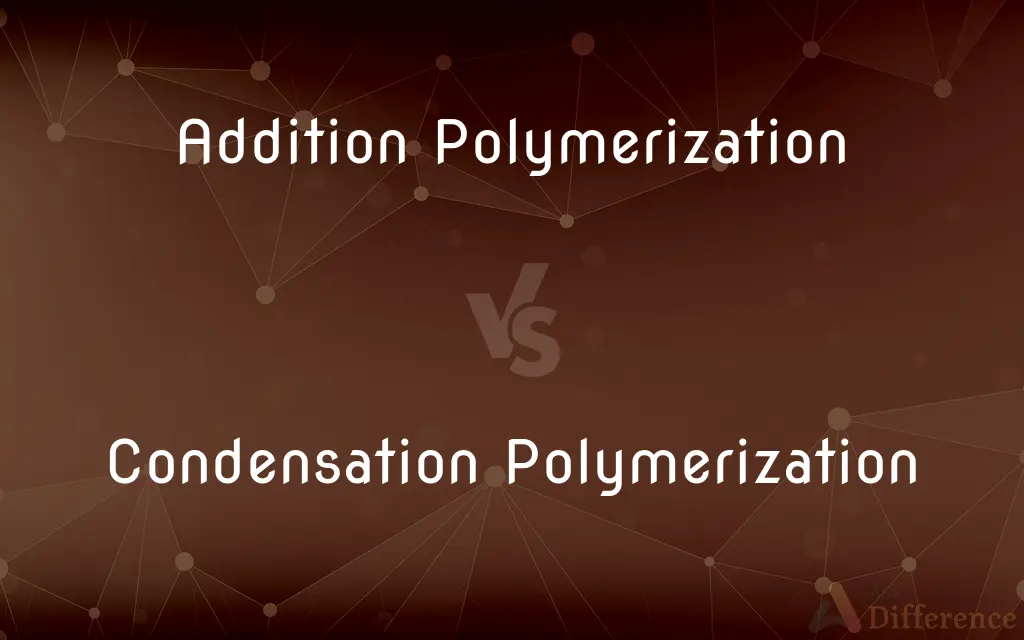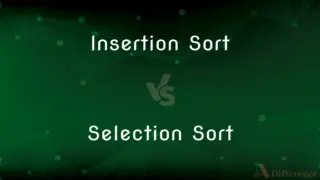Addition Polymerization vs. Condensation Polymerization — What's the Difference?
By Tayyaba Rehman — Published on January 3, 2024
Addition polymerization involves monomers joining without byproduct formation, while condensation polymerization involves monomers joining with the release of a small molecule, like water.

Difference Between Addition Polymerization and Condensation Polymerization
Table of Contents
ADVERTISEMENT
Key Differences
Addition polymerization occurs when unsaturated monomer molecules, typically with double bonds, join together in a chain reaction. This process does not involve the elimination of any small molecules. In contrast, condensation polymerization involves the combination of monomers with the simultaneous release of a smaller molecule, such as water, ammonia, or hydrogen chloride, as a byproduct.
In addition polymerization, the growth of the polymer chain is typically initiated by free radicals, cations, or anions, which open the double bond of the monomers, allowing them to link together. Condensation polymerization, on the other hand, usually involves a step-growth mechanism where bifunctional or multifunctional monomer units react to form the polymer and a small byproduct.
Polymers formed through addition polymerization tend to have a simpler structure as they mirror the structure of the original monomer. Examples include polyethylene and polystyrene. Condensation polymers often have more complex structures due to the involvement of two different types of monomers, such as in the formation of polyesters and polyamides.
Addition polymerization typically requires high pressure and temperature conditions and is a faster process, suitable for industrial-scale production. Condensation polymerization can occur under milder conditions but often requires catalysts and can be slower due to the step-growth nature of the reaction.
The applications of these polymers vary based on their properties. Addition polymers, being generally more chemically resistant and having a high strength-to-weight ratio, are used in plastics, packaging, and insulation. Condensation polymers are often used in fibers, engineering thermoplastics, and resins due to their diverse structures and functionalities.
ADVERTISEMENT
Comparison Chart
Byproduct Formation
No byproducts
Formation of small molecules like water
Polymer Structure
Simpler, mirrors monomers
More complex, often involving two types of monomers
Reaction Mechanism
Chain growth mechanism
Step growth mechanism
Reaction Conditions
High pressure and temperature
Milder conditions, often with catalysts
Typical Applications
Plastics, packaging, insulation
Fibers, thermoplastics, resins
Compare with Definitions
Addition Polymerization
Chain Growth Process: Monomers add to a growing chain.
Polyethylene is made through addition polymerization of ethylene.
Condensation Polymerization
Used in Fibers and Plastics: Common in textile and plastic industries.
Condensation polymerization is key in manufacturing PET bottles.
Addition Polymerization
Unsaturated Monomers: Uses monomers with double bonds.
Addition polymerization is common with unsaturated monomers like propylene.
Condensation Polymerization
Bifunctional Monomers: Utilizes monomers with two functional groups.
Condensation polymerization of glycol and adipic acid produces polyesters.
Addition Polymerization
Free Radical Initiation: Often starts with free radicals.
The production of polystyrene involves addition polymerization initiated by free radicals.
Condensation Polymerization
Step Growth Polymerization: Involves a stepwise reaction.
Nylon is synthesized through condensation polymerization of diamine and dicarboxylic acid.
Addition Polymerization
No Byproducts: Does not produce small byproducts.
The production of PVC through addition polymerization does not yield any byproducts.
Condensation Polymerization
Releases Small Molecules: Produces byproducts like water.
The formation of polyester involves releasing water as a byproduct.
Addition Polymerization
Industrial Production: Suitable for large-scale production.
Addition polymerization is widely used in the industrial production of synthetic rubber.
Condensation Polymerization
Complex Polymer Structures: Results in more diverse polymer structures.
Kevlar, a high-strength material, is made through condensation polymerization.
Common Curiosities
Are polymers from addition polymerization recyclable?
Many, such as polyethylene and polystyrene, are recyclable.
Can condensation polymerization be reversed?
Yes, under certain conditions, the process can be reversed, unlike addition polymerization.
What makes condensation polymers suitable for textiles?
Their complex structures allow for strength, flexibility, and durability, desirable in textiles.
Why are addition polymers often used in packaging?
Due to their chemical resistance and strength-to-weight ratio.
Can addition polymerization occur without catalysts?
While possible, catalysts significantly speed up the reaction.
Are condensation polymers generally more biodegradable?
Yes, many condensation polymers are more biodegradable than addition polymers.
What kind of monomers are used in addition polymerization?
Unsaturated monomers, typically with C=C double bonds.
What is a key feature of addition polymerization?
It involves monomers adding to a growing polymer chain without creating byproducts.
Are there environmental concerns with either polymerization process?
Both processes have environmental impacts, especially concerning the production and disposal of plastics.
Can both types of polymers be used in medical applications?
Yes, specific polymers from both types are used in various medical applications.
Are addition polymers usually thermoplastics?
Yes, many addition polymers, like polyethylene, are thermoplastics.
Is addition polymerization faster than condensation polymerization?
Generally, yes, addition polymerization tends to be a quicker process.
Is condensation polymerization more versatile than addition polymerization?
Yes, it can produce a wider variety of polymers with different properties.
What is an example of a small molecule released during condensation polymerization?
Water is the most common byproduct.
Can both types of polymerization be used to make fibers?
Yes, but condensation polymerization is more commonly used for fibers.
Share Your Discovery

Previous Comparison
new vs. malloc()
Next Comparison
Insertion Sort vs. Selection SortAuthor Spotlight
Written by
Tayyaba RehmanTayyaba Rehman is a distinguished writer, currently serving as a primary contributor to askdifference.com. As a researcher in semantics and etymology, Tayyaba's passion for the complexity of languages and their distinctions has found a perfect home on the platform. Tayyaba delves into the intricacies of language, distinguishing between commonly confused words and phrases, thereby providing clarity for readers worldwide.












































